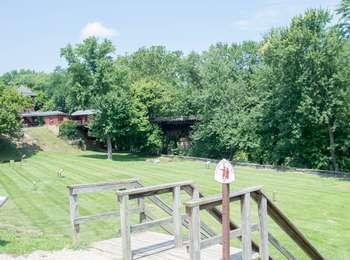Last updated: May 5, 2022
Place
Armory Grounds

Historical/Interpretive Information/Exhibits
The United States Armory at Harpers Ferry produced more than 600,000 military rifles and muskets in a 60 year period, spanning from Thomas Jefferson's presidency to the inauguration of Abraham Lincoln.
The United States Armory was the main reason Meriwether Lewis came to Harpers Ferry. Lewis needed dependable weapons and supplies from the armory to succeed on his mission. The quality of the armorers' handiwork would also mean the difference between life and death for Lewis and his men. In 1803, the armory consisted of ten buildings just upstream and underneath the existing railroad embankment.
Weapons produced at the armory were the target of John Brown's Raid in October, 1859. Brown intended to use firearms seized at Harpers Ferry to commence a war to end slavery. Brown failed in his attempt because he never escaped from Harpers Ferry. After 36 hours of holding the armory, Brown was captured by U.S. Marines commanded by Lt. Col. Robert E. Lee, assisted by Lt. J.E.B. Stuart, in the armory Fire Engine House. Sixteen months following Brown's raid, Civil War erupted.
At the beginning of the Civil War, the Virginia militia advanced upon Harpers Ferry to seize the musket and rifle factories. The United States troops, who were guarding the armory, discovered themselves outnumbered by the encroaching Virginia militia and Lt. Roger Jones ordered the Musket Factory to be set on fire at 10 p.m. on April 18, 1861. Local citizens and the Virginia militia rapidly doused the flames before much damage could be done in order to save the armory.
The armory machinery was then dismantled by the militia and moved south during the first weeks of May 1861 with Col. Thomas Jonathan Jackson supervising. Machinery from the factories ended up in Richmond, Virginia and Fayetteville, North Carolina to aid the Confederacy. Many of the Harpers Ferry armory employees relocated further south to manufacture weapons for the new Confederacy. The armory was the economic life of the town and when the armory jobs moved south, Harpers Ferry lost businesses. Many civilians in Harpers Ferry left the area, and the town became "a ghost of its former self."
The Confederates abandoned Harpers Ferry on June 14, 1861 when garrison commander Brig. Gen. Joseph E. Johnston ordered the armory buildings destroyed. All that was left of the Musket Factory was the brick walls, which were entangled with twisted and melted metal. Just two short weeks later, the Rifle Factory also was destroyed and the mighty industry of Harpers Ferry now was a silent ghostly ruin.
Nine months later, in March 1862, the armory ruins were restored by the Union Army who occupied Harpers Ferry. The Union army was launching its first full-scale invasion of the Shenandoah Valley and the former Musket Factory buildings were re-roofed to be transformed into a quartermaster and commissary depot. Supplies were brought in through the Baltimore & Ohio Railroad and were then shipped further south to the army operating in the Shenandoah Valley. The Union continued to utilize the armory for this purpose until the end of the war.
The Armory was threatened by several Confederate advances, which resulted in repeated destructions of the Union armory supply depot. The first attack on the Union controlled Armory was in September 1862, when the Confederates captured Harpers Ferry and removed as much supplies that they possibly could. The Confederates took it one step further and set the Armory on fire on September 18. The Union returned quickly to the destroyed armory to rebuild it but ten months later the armory depot was destroyed again in July, 1863. The Union returned to the ruins, once more, and rebuilt but the Confederates would strike again in July 1864.
Jubal Early's attack in July 1864 would be the last Confederates disturbance at the depot and the Union would rebuild to use the Armory again. The armory served as the base of operations for Philip Sheridan's 1864 Valley Campaign, which that resulted in the defeat of the Confederate army in the Shenandoah Valley.
United States Armory Grounds and Potomac Riverfront Cultural Landscape
